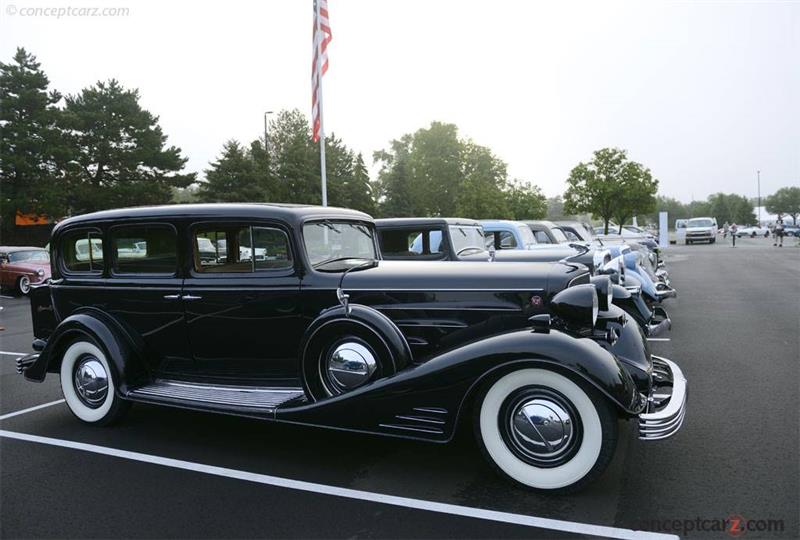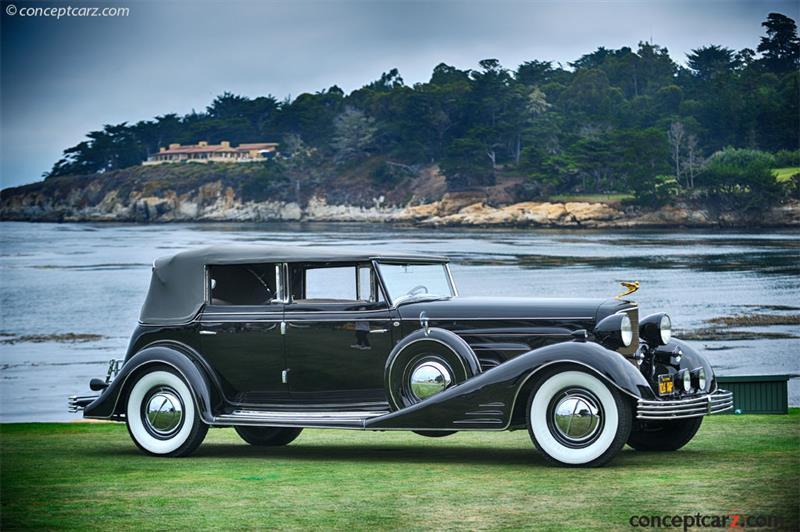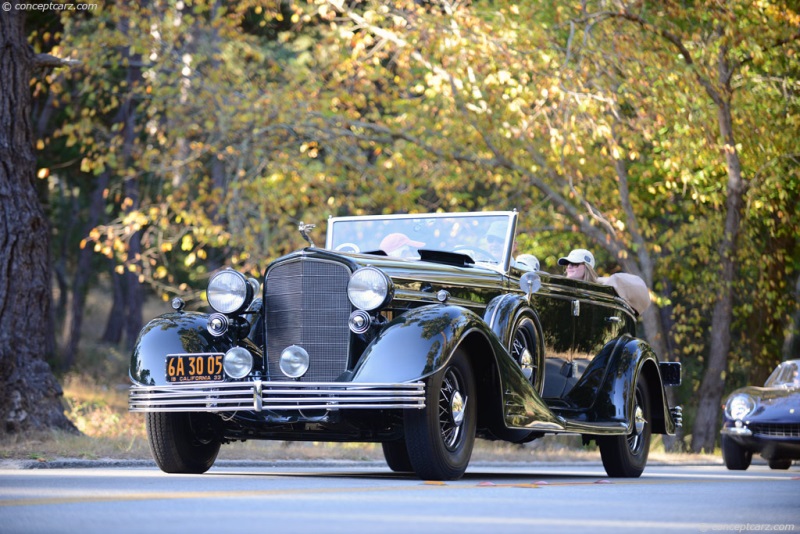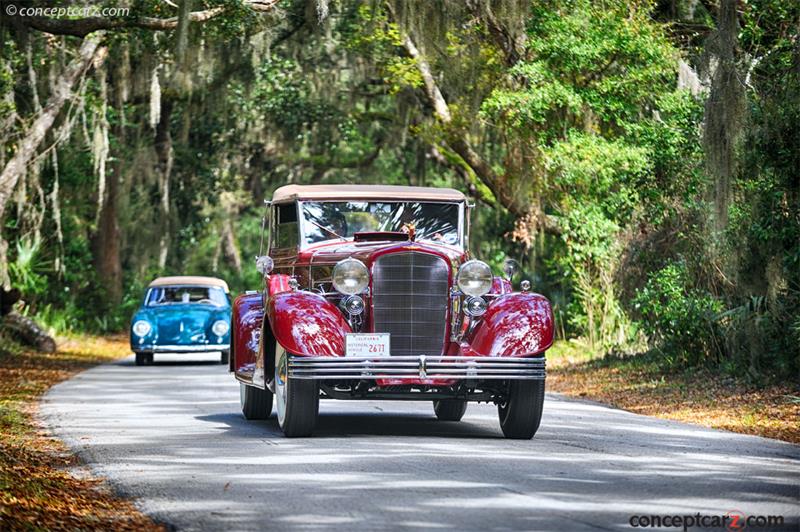Although the Cadillac V-16 did not reach the intended sales quantities, it succeeded in so many other facets. It was the catalyst for the cylinder wars that sent other luxury automakers scrambling to catch up, many spending what little resources they had to offer a suitable contender, pushing many to the brink of financial collapse, while others succumbed to the relentless pressure inflicted by Cadillac, through its onslaught of mechanical and stylistic prowess.
The V-16 Cadillac initially sold well, but the fast-shrinking Depression-era market meant that it was ultimately produced in minuscule numbers, with a total production of approximately 4,076 units (marque experts state as many as 4,378 units). Despite the low numbers, its longevity was impressive, lasting through 1940, including a completely redesigned engine for the last three years.
The clandestine 'Sixteen' project began in 1926, and its introduction coincided with the stock market crash and the start of the Great Depression. Although the timing of the introduction was unfortunate, its development occurred at a comfortable time for Cadillac, where they had the time and resources to undertake such a lofty endeavor. Luxury manufacturers were forced to compete with a paragon model of their own in the early 1930s, as sales kept falling and profits were non-existent as the Great Depression tightened its grip on the market.
Cadillac was able to weather the lean years of the Depression due to the vast resources of General Motors, including Chevrolet, Pontiac, Oldsmobile, Buick, and LaSalle. Many of the technologies, mechanical innovations, safety features, and styling successes introduced within the G.M. family were shared with the siblings. The shared components and common corporate management structure created substantial economies of scale.
The Cadillac V-16 became the ultimate status symbol within the industry, with an engine size that dwarfed all others on the road, offering plenty of power, exclusivity, and prestige that the luxury segment demanded. It offered the capability to leisurely carry the large and stately bodies outfitted with luxurious amenities and fine styling treatments.
The sixteen-cylinder was an engineering marvel, the work of Owen Milton Nacker, who had been recruited by then Cadillac chief, Lawrence Fisher. Research into the project began in 1926, and preliminary development and testing occurred from 1927 through 1929. A cloud of secrecy surrounded the project, with many falsehoods alluding to its application for buses or aircraft. The resulting design used modern overhead-valve cylinder heads, external manifolds, and a 45-degree cylinder bank angle. The setup allowed for ease of access within the engine compartment for repairs and maintenance. The mechanical sophistication was complemented by its presentation and was the first automotive engine ever to be 'styled' with completely hidden wiring and the use of polished aluminum, porcelain, and a pair of beautiful valve covers with brushed aluminum ridges prominently featuring the Cadillac emblem.
Cadillac conservatively rated the engine at 175 horsepower and it delivered incredible low-end torque of 320 foot-pounds at just 1,200 to 1,500 engine revolutions. This was more than adequate to propel Cadillac's massive long-wheelbase chassis and majestic bodies by Fleetwood and other talented coachbuilders. Along with power and beauty, the engine was incredibly smooth, thanks to evenly-spaced firing intervals and a large but well-balanced forged crankshaft, supported by five main bearings. The hydraulic valve silencers contributed to its whisper-quiet operation. Other innovations incorporated into the V-16 were a silicon-aluminum crankcase, five-point engine mounts, carefully engineered pistons and rings, plus a single distributor with two sets of breaker points, controlled by two separate ignition coils.
Cadillac stunned the fine car market on January 4th of 1930 at the New York Auto Show with the introduction of its new V-16 model, instantly catapulting itself to the head of the luxury class. With the competition 'on the ropes,' Cadillac delivered a knock-out blow with a twelve-cylinder model for 1931. The eight-cylinder Cadillac occupied the mid-to-high $2,000 range and rested on a 134-inch wheelbase, the Twelve was priced in the high-$3,000 to low-$4,000 range and rode on a 140-inch wheelbase (the commercial chassis measured 152-inches), and prices for the range-topping Series 452 Sixteen began at the high-$5,000 range, quickly rising into the $7,000 and $8,000s, with many costing ten times the cost of a contemporary Chevrolet or Ford.
Mr. Fisher met Harley Earl in 1926 while touring Cadillac dealerships throughout the U.S. Earl had created a number of designs on the Cadillac chassis for the Don Lee dealership in San Francisco, prompting Mr. Fisher to offer him a consulting job in Detroit. Both individuals traveled to Europe in the Fall of 1927 where the European styling influenced future Harley Earl-designed projects. After returning from Europe, Earl was placed in charge of the newly formed G.M. Art and Colour department.
Within the G.M. hierarchy, there was a significant price gap between the Cadillac and Buick line, a problem solved with the introduction of the LaSalle marque in 1927. The first designs created by Earl and the Art and Colour department were applied to the LaSalle. The designs were so successful that within a few years, the Cadillac and were updated to resemble the design. Alongside the catalog customs built mostly by Fleetwood and a few by Fisher, several full-custom bodies were built by Waterhouse, Vanden Plas, Pinin Farina, Murphy, Saoutchik, Fleetwood, and others. The list of catalog bodies, however, was extensive with over 50 body styles, with most being five- or seven-passenger sedans or Imperials. A smaller portion was open or convertible configurations, and others were coupes or town cars. Many had a seven-degree Vee-type swing-out windshield, while others were set at 16-, 18-, 21- or 22-degree rake.
1933 Cadillac 452C V16
The Cadillacs of 1933 were at the forefront of design, with streamlined bodies, sectioned bumpers, a vee-shaped grill with a standard painted or optional chrome radiator shell. The front and rear fenders received skirts, the radiator filler cap was placed under the hood, and the fender tie-bar became sectioned, with the center section traveling behind the grille. A no-draft Individually Controlled Ventilation (I.C.V.) system was introduced for the front doors and rear quarter windows These pivoting vent windows went through design changes during its first year of production as the system was still being perfected. Initially, the sealing channel was attached to the window glass, so the front door window needed to be lowered to disengage the channel at its front edge from the vent window, allowing the vent window to pivot. Later production vehicles received an updated version of the I.C.V. where the sealing channel was attached to the door frame and could be operated independently of the window glass.
Cadillac had standardized the bodies of the Eight, Twelve, and Sixteen-cylinder models with distinguishable features, short of checking the engine, was the size of the footprint and by the emblems. Both the Eight and Twelve rested on a 134- and 140-inch wheelbase platform with catalog bodies built by Fisher and Fleetwood. The 452-C Sixteen used a 143- and 149-inch wheelbase and measured approximately 216- to 222-inches.
The 452 cubic-inch engine was backed by a three-speed selective, synchromesh transmission with a twin-disc clutch. The engine received a higher compression ratio to better cope with the improved gasoline. All Sixteens were built with the left-hand drive configuration as Cadillac did not offer a right-hand drive. Stopping power was provided by mechanical brakes on all four wheels with 15-inch drums and vacuum assist. The suspension was comprised of a solid front axle with semi-elliptic leaf springs and hydraulic dampers, and a 3/4-floating rear axle with semi-elliptic leaf springs. Early cars rode on 18-inch wheels which were quickly reduced to 17 inches, adding to the overall low-profile stance that Mr. Earl favored, highlighted by the designs of the late-1950s.
Cadillac announced it would build 400 vehicles for the 1933 model year but ultimately built just 126 vehicles with most being the five- or seven-passenger sedan body style. The designs were similar to the rest of the Cadillac lineup, distinguished by the goddess mascot, a four-bar bumper, spinner hubcaps, and the lack of a crankhole cover in the grille. The front fender skirts had vertical louvers on promotional material but production vehicles had three horizontal louvers similar to the louvers on the hood.
Among the vast list of body styles offered by Fleetwood were coupes, sport coupes, sport convertible coupe, convertible coupes, town cabriolets, Imperial cabriolets, Sport Imperial, Sport Phaeton, town coupes, roadsters, aerodynamic coupe, sedan, sport sedan, town brougham, limousine brougham, town sedan, sedan cabriolet, limousines, all-weather phaetons, and tourer. Fisher catalog bodies included a coupe and a convertible coupe on the 143-inch wheelbase platform. The convertible coupe and coupe by Fleetwood were also built on the 1943-inch platform. The rest used the larger 149-inch wheelbase. Prices generally began in the $6,250 range and rose dramatically from there.
In 1938, the second generation of the V-16 was introduced, the 'Series 90,' alongside the new L-head V16 engine with a 431 cubic-inch displacement with an in-block valve design, a wider 135-degree V-ange, twin fuel pumps, twin distributors, twin water pumps, a nine main bearing crankshaft, and twin carburetion. Its 185 horsepower was the same as the original V-16, however, it offered greater smoothness than its predecessors along with slightly improved fuel economy and quicker acceleration. The wheelbase decreased to 141-inches and the overall length remained 222-inches.
Production of the 1940 Cadillac Sixteen models ended in December of 1939 with approximately 4,076 examples built during its eleven-year production lifespan.
by Daniel Vaughan | Feb 2021
The V-16 Cadillac initially sold well, but the fast-shrinking Depression-era market meant that it was ultimately produced in minuscule numbers, with a total production of approximately 4,076 units (marque experts state as many as 4,378 units). Despite the low numbers, its longevity was impressive, lasting through 1940, including a completely redesigned engine for the last three years.
The clandestine 'Sixteen' project began in 1926, and its introduction coincided with the stock market crash and the start of the Great Depression. Although the timing of the introduction was unfortunate, its development occurred at a comfortable time for Cadillac, where they had the time and resources to undertake such a lofty endeavor. Luxury manufacturers were forced to compete with a paragon model of their own in the early 1930s, as sales kept falling and profits were non-existent as the Great Depression tightened its grip on the market.
Cadillac was able to weather the lean years of the Depression due to the vast resources of General Motors, including Chevrolet, Pontiac, Oldsmobile, Buick, and LaSalle. Many of the technologies, mechanical innovations, safety features, and styling successes introduced within the G.M. family were shared with the siblings. The shared components and common corporate management structure created substantial economies of scale.
The Cadillac V-16 became the ultimate status symbol within the industry, with an engine size that dwarfed all others on the road, offering plenty of power, exclusivity, and prestige that the luxury segment demanded. It offered the capability to leisurely carry the large and stately bodies outfitted with luxurious amenities and fine styling treatments.
The sixteen-cylinder was an engineering marvel, the work of Owen Milton Nacker, who had been recruited by then Cadillac chief, Lawrence Fisher. Research into the project began in 1926, and preliminary development and testing occurred from 1927 through 1929. A cloud of secrecy surrounded the project, with many falsehoods alluding to its application for buses or aircraft. The resulting design used modern overhead-valve cylinder heads, external manifolds, and a 45-degree cylinder bank angle. The setup allowed for ease of access within the engine compartment for repairs and maintenance. The mechanical sophistication was complemented by its presentation and was the first automotive engine ever to be 'styled' with completely hidden wiring and the use of polished aluminum, porcelain, and a pair of beautiful valve covers with brushed aluminum ridges prominently featuring the Cadillac emblem.
Cadillac conservatively rated the engine at 175 horsepower and it delivered incredible low-end torque of 320 foot-pounds at just 1,200 to 1,500 engine revolutions. This was more than adequate to propel Cadillac's massive long-wheelbase chassis and majestic bodies by Fleetwood and other talented coachbuilders. Along with power and beauty, the engine was incredibly smooth, thanks to evenly-spaced firing intervals and a large but well-balanced forged crankshaft, supported by five main bearings. The hydraulic valve silencers contributed to its whisper-quiet operation. Other innovations incorporated into the V-16 were a silicon-aluminum crankcase, five-point engine mounts, carefully engineered pistons and rings, plus a single distributor with two sets of breaker points, controlled by two separate ignition coils.
Cadillac stunned the fine car market on January 4th of 1930 at the New York Auto Show with the introduction of its new V-16 model, instantly catapulting itself to the head of the luxury class. With the competition 'on the ropes,' Cadillac delivered a knock-out blow with a twelve-cylinder model for 1931. The eight-cylinder Cadillac occupied the mid-to-high $2,000 range and rested on a 134-inch wheelbase, the Twelve was priced in the high-$3,000 to low-$4,000 range and rode on a 140-inch wheelbase (the commercial chassis measured 152-inches), and prices for the range-topping Series 452 Sixteen began at the high-$5,000 range, quickly rising into the $7,000 and $8,000s, with many costing ten times the cost of a contemporary Chevrolet or Ford.
Mr. Fisher met Harley Earl in 1926 while touring Cadillac dealerships throughout the U.S. Earl had created a number of designs on the Cadillac chassis for the Don Lee dealership in San Francisco, prompting Mr. Fisher to offer him a consulting job in Detroit. Both individuals traveled to Europe in the Fall of 1927 where the European styling influenced future Harley Earl-designed projects. After returning from Europe, Earl was placed in charge of the newly formed G.M. Art and Colour department.
Within the G.M. hierarchy, there was a significant price gap between the Cadillac and Buick line, a problem solved with the introduction of the LaSalle marque in 1927. The first designs created by Earl and the Art and Colour department were applied to the LaSalle. The designs were so successful that within a few years, the Cadillac and were updated to resemble the design. Alongside the catalog customs built mostly by Fleetwood and a few by Fisher, several full-custom bodies were built by Waterhouse, Vanden Plas, Pinin Farina, Murphy, Saoutchik, Fleetwood, and others. The list of catalog bodies, however, was extensive with over 50 body styles, with most being five- or seven-passenger sedans or Imperials. A smaller portion was open or convertible configurations, and others were coupes or town cars. Many had a seven-degree Vee-type swing-out windshield, while others were set at 16-, 18-, 21- or 22-degree rake.
1933 Cadillac 452C V16
The Cadillacs of 1933 were at the forefront of design, with streamlined bodies, sectioned bumpers, a vee-shaped grill with a standard painted or optional chrome radiator shell. The front and rear fenders received skirts, the radiator filler cap was placed under the hood, and the fender tie-bar became sectioned, with the center section traveling behind the grille. A no-draft Individually Controlled Ventilation (I.C.V.) system was introduced for the front doors and rear quarter windows These pivoting vent windows went through design changes during its first year of production as the system was still being perfected. Initially, the sealing channel was attached to the window glass, so the front door window needed to be lowered to disengage the channel at its front edge from the vent window, allowing the vent window to pivot. Later production vehicles received an updated version of the I.C.V. where the sealing channel was attached to the door frame and could be operated independently of the window glass.
Cadillac had standardized the bodies of the Eight, Twelve, and Sixteen-cylinder models with distinguishable features, short of checking the engine, was the size of the footprint and by the emblems. Both the Eight and Twelve rested on a 134- and 140-inch wheelbase platform with catalog bodies built by Fisher and Fleetwood. The 452-C Sixteen used a 143- and 149-inch wheelbase and measured approximately 216- to 222-inches.
The 452 cubic-inch engine was backed by a three-speed selective, synchromesh transmission with a twin-disc clutch. The engine received a higher compression ratio to better cope with the improved gasoline. All Sixteens were built with the left-hand drive configuration as Cadillac did not offer a right-hand drive. Stopping power was provided by mechanical brakes on all four wheels with 15-inch drums and vacuum assist. The suspension was comprised of a solid front axle with semi-elliptic leaf springs and hydraulic dampers, and a 3/4-floating rear axle with semi-elliptic leaf springs. Early cars rode on 18-inch wheels which were quickly reduced to 17 inches, adding to the overall low-profile stance that Mr. Earl favored, highlighted by the designs of the late-1950s.
Cadillac announced it would build 400 vehicles for the 1933 model year but ultimately built just 126 vehicles with most being the five- or seven-passenger sedan body style. The designs were similar to the rest of the Cadillac lineup, distinguished by the goddess mascot, a four-bar bumper, spinner hubcaps, and the lack of a crankhole cover in the grille. The front fender skirts had vertical louvers on promotional material but production vehicles had three horizontal louvers similar to the louvers on the hood.
Among the vast list of body styles offered by Fleetwood were coupes, sport coupes, sport convertible coupe, convertible coupes, town cabriolets, Imperial cabriolets, Sport Imperial, Sport Phaeton, town coupes, roadsters, aerodynamic coupe, sedan, sport sedan, town brougham, limousine brougham, town sedan, sedan cabriolet, limousines, all-weather phaetons, and tourer. Fisher catalog bodies included a coupe and a convertible coupe on the 143-inch wheelbase platform. The convertible coupe and coupe by Fleetwood were also built on the 1943-inch platform. The rest used the larger 149-inch wheelbase. Prices generally began in the $6,250 range and rose dramatically from there.
In 1938, the second generation of the V-16 was introduced, the 'Series 90,' alongside the new L-head V16 engine with a 431 cubic-inch displacement with an in-block valve design, a wider 135-degree V-ange, twin fuel pumps, twin distributors, twin water pumps, a nine main bearing crankshaft, and twin carburetion. Its 185 horsepower was the same as the original V-16, however, it offered greater smoothness than its predecessors along with slightly improved fuel economy and quicker acceleration. The wheelbase decreased to 141-inches and the overall length remained 222-inches.
Production of the 1940 Cadillac Sixteen models ended in December of 1939 with approximately 4,076 examples built during its eleven-year production lifespan.
by Daniel Vaughan | Feb 2021
Related Reading : Cadillac Series 452/90 History
Henry Martin Leland and his son Wilfred were partly responsible for making Cadillac one of the finest of all American Automobiles. Henry was renowned for his precision engineering and for standardizing manufacturing. He helped make Cadillac into one of the finest of all American Automobiles. Later, he founded Lincoln. Even after the Lelands departed from Cadillac, the marque remained a top-of-the-line....
Continue Reading >>
Continue Reading >>
Cadillac
Similarly Priced Vehicles
Cadillac Monthly Sales Volume
March 2023
36,321
1933 Cadillac Series 452-C Sixteen Vehicle Profiles
Recent Vehicle Additions
Performance and Specification Comparison
Price Comparison
$2,700 - $4,145
$3,400 - $4,845
Series 452/90 Specification Comparison by Year
Year
Production
Wheelbase
Engine
Prices
300
143.00 in., 149.00 in., 165.00 in.
16 cyl., 452.00 CID., 165.00hp
$4,495 - $5,945
Related Automotive News

Historic and Prestigious Classics to Take Center Stage at Gooding & Company's Pebble Beach Auctions; Full Catalogue Launches Online Today
The undisputed star of the show is the 1937 Bugatti Type 57SC Atalante, alongside a 1930 Bentley 4 12 Litre Supercharged Blower Sports Tourer and a 1931 Bentley Eight Litre Sports Tourer.
The official auction house of the Pebble Beach Concours...

Mecum Chicago 2021 Collector Car Auction Set for Oct. 21-23
1,000 Vehicles on Offer at Renaissance Schaumburg Convention Center
Mecum Auctions, the worlds largest collector car auction company, will hold Mecum Chicago 2021—the areas only annual collector car auction event—this Oct. 21-23 at the Renaissance...

Gooding & Company Unveils Online Catalogue for Pebble Beach Auctions, Announces Additional Star Consignments
The catalogue features major new additions from the auction house, including a 1959 Ferrari 250 GT LWB California Spider Competizione, a 1998 Mercedes-Benz AMG CLK GTR Strassenversion, a 1957 Maserati 200 SI, and a 1961 Aston Martin DB4 GT.
The...

SHOW-STOPPING AUTOMOBILES AT RM SOTHEBY'S AMELIA ISLAND CONCOURS D'ELEGANCE SALE
RM Sothebys readies for its 18th annual Amelia Island Concours dElegance sale, March 12 in Florida
Star attractions 1939 Mercedes-Benz 540 K Spezial Cabriolet A and 1962 Ferrari 400 Superamerica LWB Coupe Aerodinamico lead roster of more than...

Magnificent Series of Coachbuilt Classics To Grace RM's Amelia Island Concours D'Elegance Sale
RM Auctions returns as the official auction house of the Amelia Island Concours dElegance, March 9, 2013
Single-day sale features breathtaking roster of more than 80 investment-quality collector cars
Notable highlights include an outstanding s...





































